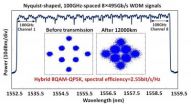(Press-News.org) Antibiotic-resistant Escherichia coli (E. coli) continues to proliferate, driven largely by expansion of a strain of E. coli know as sequence type ST131. A new study points to hospitals and long-term care facilities (LTCF) as settings in which this antibiotic-resistant strain is increasingly found. The study is published in the April issue of Infection Control and Hospital Epidemiology, the journal of the Society for Healthcare Epidemiology of America.
E. coli is the most common gram-negative pathogen, causing both gastrointestinal disease and extraintestinal infections such as pneumonia, meningitis, and bloodstream, urinary tract, abdominal, and wound infections. Strains of E. coli that are resistant to single or multiple classes of antibiotics are becoming more prevalent. E. coli ST131 is commonly associated with fluoroquinolone resistance.
"The expansion of E. coli strain ST131 is recognized as a pandemic, but has received comparatively little attention in the United States," said Ritu Banerjee, lead investigator of the study. "Alarmingly, the pace of new antibiotic development has not kept up with the emergence of antibiotic-resistant E. coli, making development of strategies to halt further emergence and spread of these strains a public health priority."
In this retrospective study, investigators evaluated nearly 300 consecutive patients in Olmsted County, Minnesota with extraintestinal E. coli infections and found ST131 to be a dominant, antimicrobial-resistant clonal group associated with older age, long-term care facility residence, complicated infections, history of urinary tract infection, and prior antimicrobial use.
LTCF residence was the strongest predictor of ST131 infection, with LTCF residents having 8 times the risk of contracting E. coli ST131 compared with non-LTCF residents. This trend coincides with the increasing prevalence of ST131 among patients 65 years and older. It is likely that extensive antibiotic exposure, close contact with other antibiotic-exposed individuals, age and health-associated alterations in intestinal microbiota all contribute to the high prevalence of ST131 among the elderly population.
Patients with ST131 isolates were often treated with ineffective antibiotics at first and as a result they had recurrent or persistent symptoms. In the cohort, ST131 isolates were also more than twice as likely to be healthcare-associated infections as compared to community-associated infections.
"The finding that clonal expansion of ST131 is occurring primarily in healthcare and long-term care facilities indicates an urgent need for improved antibiotic use and infection control practices within such institutions, both to reduce selection for ST131 and to block further transmission. Efforts that focus on reducing overuse and misuse of fluoroquinolones are likely to have the greatest impact on ST131 prevalence, given the strong association between ST131 and fluoroquinolone resistance," said Banerjee.
###
Ritu Banerjee, Brian Johnston, Christine Lohse, Stephen B.Porter, Connie Clabots and James R. Johnson. "Escherichia coli Sequence Type 131 Is a Dominant, Antimicrobial-Resistant Clonal Group Associated with Healthcare and Elderly Hosts." Infection Control and Hospital Epidemiology 34:4 (April 2013).
Published through a partnership between the Society for Healthcare Epidemiology of America and The University of Chicago Press, Infection Control and Hospital Epidemiology provides original, peer-reviewed scientific articles for anyone involved with an infection control or epidemiology program in a hospital or healthcare facility. ICHE is ranked 15 out of 140 journals in its discipline in the latest Journal Citation Reports from Thomson Reuters.
SHEA is a professional society representing more than 2,000 physicians and other healthcare professionals around the world with expertise in healthcare epidemiology and infection prevention and control. SHEA's mission is to prevent and control healthcare-associated infections and advance the field of healthcare epidemiology. The society leads this field by promoting science and research and providing high-quality education and training in epidemiologic methods and prevention strategies. SHEA upholds the value and critical contributions of healthcare epidemiology to improving patient care and healthcare worker safety in all healthcare settings. Visit SHEA online at http://www.shea-online.org, on Twitter @SHEA_Epi and Facebook at http://www.facebook.com/SHEApreventingHAIs. END
Infants as young as nine months old prefer individuals who punish those who are not like them, and this seemingly innate mean streak grows stronger in the next five months of life, a study by researchers at Yale University has found.
Babies, like adults, prefer individuals who like the same things they do. A new study reports that they want individuals who share their tastes to be treated well by others, but want those whose tastes differ from their own to be treated badly. The study of 200 nine- and 14-month-old infants was published online in Psychological Science, ...
As network carriers debate the next Ethernet standard—and whether transmission speeds of 400 gigabit per second or 1 terabit per second should be the norm—engineers are working on new measures to squeeze next-generation performance out of current-generation systems.
To that end, a team from AT&T has devised a new patent pending technique enabling tuning of the modulation spectral efficiency, which allows, for the first time, 400 Gb/s signals to be sent over today's 100 gigahertz-grid optical networks over ultra-long distances. Spectral efficiency is the information rate ...
Americans work longer hours, take fewer vacation days, and retire later than employees in other industrialized countries around the globe. With such demanding careers, it's no surprise that many experience job burnout — physical, cognitive, and emotional exhaustion that results from stress at work. Researchers have found that burnout is also associated with obesity, insomnia, and anxiety.
Now Dr. Sharon Toker of Tel Aviv University's Faculty of Management and her fellow researchers — Profs. Samuel Melamed, Shlomo Berliner, David Zeltser and Itzhak Shpira of TAU's Sackler ...
Ultrafast supercomputers that operate at speeds 100 times faster than current systems are now one step closer to reality. A team of IBM researchers working on a U.S. Defense Advanced Research Projects Agency (DARPA)-funded program have found a way to transmit massive amounts of data with unprecedentedly low power consumption.
The team will describe their prototype optical link, which shatters the previous power efficiency record by half at the Optical Fiber Communication Conference and Exposition/National Fiber Optic Engineers Conference (OFC/NFOEC) in Anaheim, Calif. ...
New multicore optical fibers have many times the signal-carrying capacity of traditional single-core fibers, but their use in telecommunications has been severely restricted because of the challenge in splicing them together-- picture trying to match up and connect two separate boxes of spaghetti so that all of the noodles in each box are perfectly aligned. Now, a new splicing technique offers an automated way to do just that, with minimal losses in signal quality across the spliced sections. The method will be described at the Optical Fiber Communication Conference and ...
Philadelphia - According to a new study by researchers at the Perelman School of Medicine at the University of Pennsylvania, prostate cancer patients of urologists who own expensive radiation equipment are more likely to receive radiation treatment in lieu of surgery than patients treated by urologists without an ownership stake in the equipment. The study, now available online in the Journal of Urology, found that integrated prostate cancer centers (IPCCs), where urology and radiation oncology practices are combined, use expensive radiation-based treatments at higher rates ...
How do bone-eating worms reproduce? A new study by Norio Miyamoto and colleagues from the Japan Agency for Marine-Earth Science and Technology sheds light on this question through a detailed observation of the postembryonic development and sexual maturation of Osedax worms, also known as "zombie worms." These worms typically inhabit vertebrate bones on the seafloor. The study is published online in Springer's journal Naturwissenschaften - The Science of Nature.
Osedax is Latin for "bone-devourer," which refers to how the worms bore into the bones of whale carcasses to ...
Despite many remarkable discoveries in the field of neuroscience during the past several decades, researchers have not been able to fully crack the brain's "neural code." The neural code details how the brain's roughly 100 billion neurons turn raw sensory inputs into information we can use to see, hear and feel things in our environment.
In a perspective article published in the journal Nature Neuroscience on Feb. 25, 2013, biomedical engineering professor Garrett Stanley detailed research progress toward "reading and writing the neural code." This encompasses the ability ...
A study headed by the Miquel Crusafont Catalan Palaeontology Institute has for the first time documented detailed records of dinosaur egg fossils in the Coll de Nargó archaeological site in Lleida, Spain. Up until now, only one type of dinosaur egg had been documented in the region.
The archaeological site in Coll de Nargó containing dinosaur eggs lies some 8 kilometres to the west of the town that bears the same name in the province of Lleida. This region is home to different types of geological formations, including the Areniscas de Arén Formation and the Tremp Formation, ...
New Rochelle, NY, March 12, 2013—Little is known about the value and emotional consequences of expressing anger on the Internet. Rant-sites provide an outlet for anonymous, angry outbursts. How people feel after reading and writing rants and the effects of this behavior is explored in an article in Cyberpsychology, Behavior, and Social Networking, (http://www.liebertpub.com/cyber) a peer-reviewed journal from Mary Ann Liebert, Inc., publishers (http://www.liebertpub.com). The article is available online on the Cyberpsychology, Behavior, and Social Networking (http://www.liebertpub.com/cyber) ...







